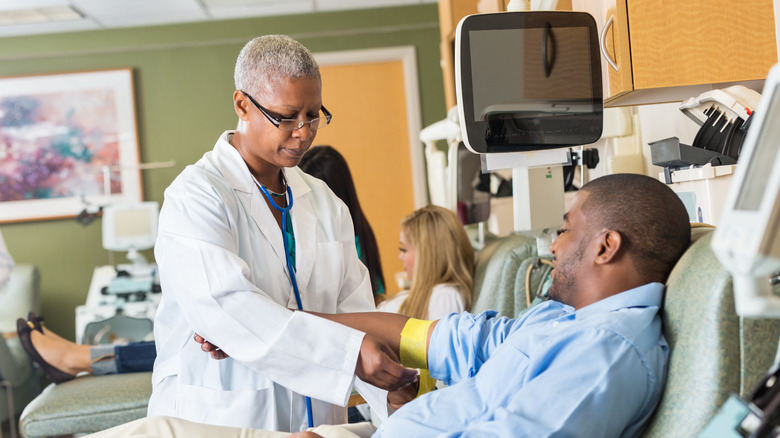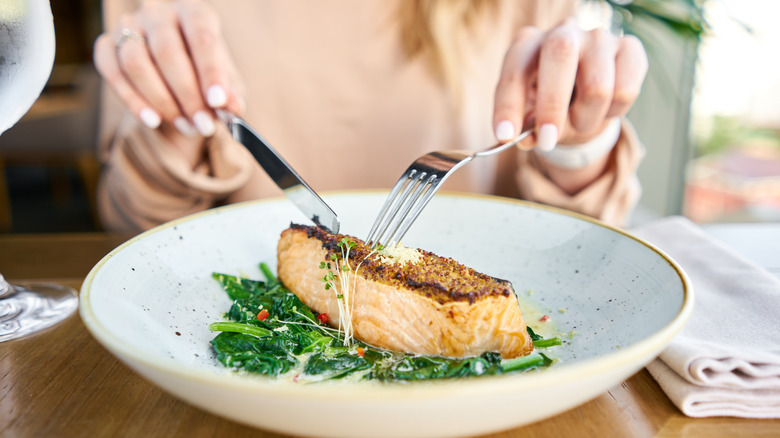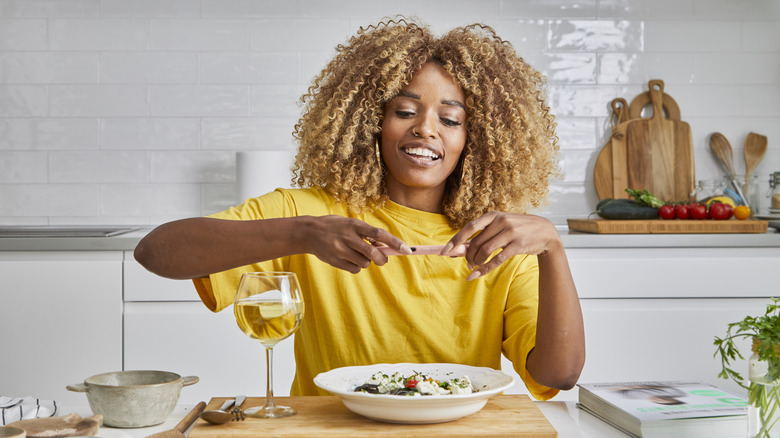The Best Foods To Eat After Having Your Blood Drawn
Blood draws can happen for a variety of reasons. Your doctor might take blood as part of your routine checkup. Blood is also typically drawn when looking for diseases affecting the body.
However, blood draws might not be part of your healthcare at all, but rather done for the health of others. According to the American Red Cross, 6.8 million people in the U.S. donate their blood to save lives every year. They also note that about 40% of blood and blood components come from donors.
Blood draws for medical reasons might only require a vial or two of blood, but a blood donation includes giving a pint of blood when you donate, states the Mayo Clinic. The American Red Cross notes that the blood donation process takes about 8-10 minutes, and the person is seated while the donation is made. You might feel some of the side effects of donating blood afterward, including fatigue or dizziness.
Since you're giving out your precious nutrients, it's important to eat specific foods to help replenish your red blood cell supply. Some of the best foods include those high in iron and B vitamins. We'll explain what some of these foods are so you can have them on hand for your next blood draw.
Stock up on foods rich in iron
Iron is an essential mineral needed for making hemoglobin, which is a protein found in red blood cells. It's used to carry oxygen from your lungs to all the other areas of your body, according to the National Institutes of Health Office of Dietary Supplements. When you have your blood drawn, eating foods rich in iron can help to replenish your iron supply since low iron can make you feel weak and tired, per the Mayo Clinic.
The American Red Cross states that two types of iron are gained from food: heme and non-heme. Heme iron is readily absorbed in your body and found in meats like chicken, poultry, beef, and pork. Non-heme iron is plant iron found in foods like spinach, peas, broccoli, and sweet potatoes. Both types of iron will help replenish your blood's stock, but heme is more easily absorbed than non-heme. However, combining the two types of iron into one rich meal can give you more bang for your buck, advises the American Red Cross.
Eating them together is only one of many ways to maximize your iron intake, though. According to Michigan State University, adding in some vitamin C can help you absorb more non-heme iron. Therefore, consider having a spinach salad with a few bell peppers or tomatoes thrown in. You can also season your sweet potato and chicken with a pinch or two of chili pepper.
Enjoy foods high in B vitamins
Another major player in the creation of red blood cells is the B vitamins. This group includes eight essential vitamins like folic acid and B12, explains Healthline. Specifically, folic acid and B12 are needed to create and grow red blood cells. Not having enough of either can lead to anemia.
You can pump up your folic acid by eating dark leafy veggies, beans, peanuts, and fresh fruits. Harvard T.H. Chan School of Public Health also notes that bread, cereals, and rice are fortified with folic acid. Your B12 vitamins can be found in meat, fish, eggs, and dairy, according to Healthline. For example, animal livers are nutrition-packed, so how about having a meal of liver and onions? You can also get your B12 by loading up on some Greek yogurt with banana or eating a few cheddar cheese wedges. Making an omelet can also boost your B12 intake.
Research published in 2008 in Transfusion Medicine says that levels of other B soluble vitamins like B6 and biotin are also necessary for those first-time and repeat donors. Make a meal out of it by including B vitamins with your iron-rich foods. Try sprinkling some beans and whole grains into your chicken and sweet potatoes. Or you can also load up on a meaty pasta.



